Standard Water Start
The water start is the prelude to a life of windsurfing. We are on the road to self-sufficiency if we can water start in both directions. At the very least we can sail one direction, fall in and turn the rig around, waterstart, and then sail in the other direction. As a windsurfer you may not learn the fancy tricks but you certainly will waterstart, many times... The waterstart I am demonstrating here is for lighter winds because getting out of the water is more challenging when the wind power is insufficient to pull you directly out of the water. In very light wind conditions, or almost no wind, then you will need a different technique so check out my No-Wind-Water-Start method.
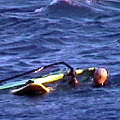
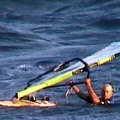
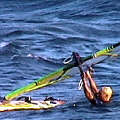
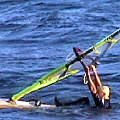
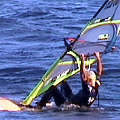
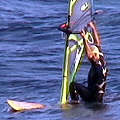
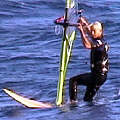
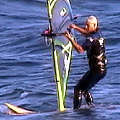
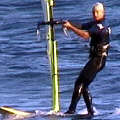
Rider: Royn Bartholdi
Steps
 1)
Orient the gear in the direction you want to sail. This means facing the board in the right direction, pulling the sail on top of the water, and getting the mast facing windward. Learn by doing: getting he board flipped around, the sail out of the water, etc... Experiment...
1)
Orient the gear in the direction you want to sail. This means facing the board in the right direction, pulling the sail on top of the water, and getting the mast facing windward. Learn by doing: getting he board flipped around, the sail out of the water, etc... Experiment...  2)
Position yourself under the sail with your hands on the boom and the sail floating above you. Also, point the board downwind with your legs extended toward the board.
2)
Position yourself under the sail with your hands on the boom and the sail floating above you. Also, point the board downwind with your legs extended toward the board.  3)
Now extend your arms to expose more sail to the wind. At this point you are not trying to pull yourself up out of the water like a pull-up in an exercise gym but rather push the sail away from you.
3)
Now extend your arms to expose more sail to the wind. At this point you are not trying to pull yourself up out of the water like a pull-up in an exercise gym but rather push the sail away from you.  4)
While keeping your arms extended, lift and place the rear foot between the footstraps and on the centerline of the board. Keep the knee bent and make sure you are bending at the waist so your body is as close as possible to the board. Remember to keep the board pointing down wind.
4)
While keeping your arms extended, lift and place the rear foot between the footstraps and on the centerline of the board. Keep the knee bent and make sure you are bending at the waist so your body is as close as possible to the board. Remember to keep the board pointing down wind.  5)
As the sail goes more vertical and you begin to feel the sail fill with a little power then place the front foot on the centerline of the board and near the mast. Remember to maintain the extension of your arms.
5)
As the sail goes more vertical and you begin to feel the sail fill with a little power then place the front foot on the centerline of the board and near the mast. Remember to maintain the extension of your arms.  6)
Now pull the heels of your feet underneath you while reaching your arms to the sky. Basically you are trying to pull the board under your body center so you can stand up on the board.
6)
Now pull the heels of your feet underneath you while reaching your arms to the sky. Basically you are trying to pull the board under your body center so you can stand up on the board.  7)
Now that the mast is vertical, you can pull the boom down into the board and stand up. Also, your body is over the center of the board. Your arms, more or less, are pulling down into the board instead of toward your body and against the power of the wind. With stronger winds you can pull toward your body because the power of the sail is sufficient to pull you out of the water like a water-skier pulling against a rope in waterskiing.
7)
Now that the mast is vertical, you can pull the boom down into the board and stand up. Also, your body is over the center of the board. Your arms, more or less, are pulling down into the board instead of toward your body and against the power of the wind. With stronger winds you can pull toward your body because the power of the sail is sufficient to pull you out of the water like a water-skier pulling against a rope in waterskiing.  8)
Shuffle the back foot forward to get your body weight more over the center of board so the tail of the board, the less buoyant section, can also come out of the water.
8)
Shuffle the back foot forward to get your body weight more over the center of board so the tail of the board, the less buoyant section, can also come out of the water.  9)
Adjust and sail away.
9)
Adjust and sail away. Tips
- A technique to get the sail to the top of the water is to push the board under the boom. The buoyancy of the board will force the sail to the top of the water with little effort on your part.
- A technique to get the sail floating above you is to push up the sail with your head.
All Contents Copyright © 2008-2025 Royn Bartholdi. All Rights Reserved